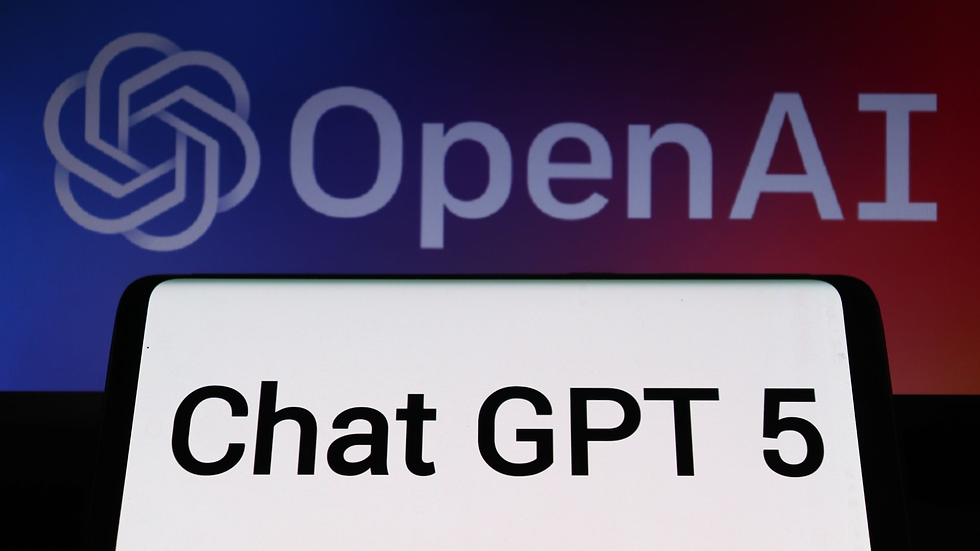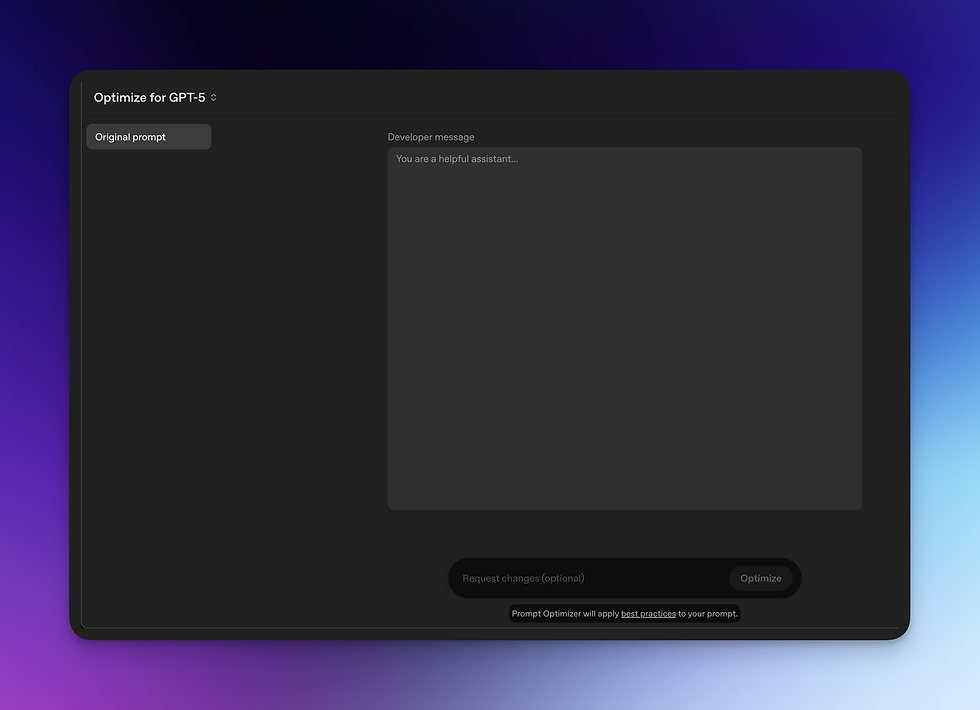The New Rules of ChatGPT-5 Prompting You Need to Know
- Olivia Johnson

- Oct 5
- 9 min read
You've upgraded to ChatGPT-5, the most advanced AI model from OpenAI, expecting a leap in performance. Yet, you're finding the opposite: your trusted, old prompts are suddenly yielding worse results. You're not alone. After its launch, millions of users reported a frustrating decline in output quality, even though they hadn't changed their prompting methods. But that's precisely the problem.
To be clear, ChatGPT-5 is an objectively more powerful model. So, why the downgrade in performance for so many? The answer lies in a fundamental architectural change that OpenAI implemented, which renders many of our old prompting habits ineffective. An estimated 95% of users are unaware of this shift and continue to get subpar outputs because they're speaking a language the new model is no longer designed to interpret loosely.
The good news is that this is a solvable problem. By understanding these core changes and adopting a few new techniques, you can not only fix your outputs but unlock a level of precision and power you couldn't achieve with previous models. This guide breaks down the essential changes in GPT-5 and provides five simple, powerful tips—sorted from easiest to hardest—that will drastically improve your results.
What Exactly Changed with ChatGPT-5?

Core Updates and Common Misconceptions
The feeling that GPT-5 is "dumber" is a common but mistaken side effect of two significant under-the-hood updates. Understanding these changes is the first step to mastering the new model.
1. Model Consolidation and the "Invisible Router"
Previously, ChatGPT Plus users had a dashboard of different specialized models to choose from. OpenAI has now consolidated these into just three core options: GPT-5, GPT-5 thinking mini, and GPT-5 thinking. While this seems like a simplification for a better user experience, it introduced a new layer of complexity: an invisible "router".
Think of this router like a customer service dispatcher. When you submit a prompt, this system automatically decides which internal model is best suited to handle your request. However, this router doesn't always work perfectly. If you simply type a prompt and hit enter as you did before, you might be routed to the most powerful model, or you might be sent to a faster, less capable one. Since the higher-reasoning models are more expensive for OpenAI to run, there's an incentive to default users to the "fastest but dumbest" option whenever possible.
2. Surgical Precision: A Double-Edged Sword
The second major change is that GPT-5 is vastly better at following instructions. This was an intentional design choice, as OpenAI specifically trained the model with AI agents in mind—systems that need to execute precise commands without deviation. For example, if an agent is told to insert a row into a specific spreadsheet, there is absolutely no room for creative interpretation.
The good news is that GPT-5 now follows our prompts with extreme precision. The bad news is that, unlike its predecessors, it's significantly worse at guessing what we mean when our prompts are vague or poorly constructed. The model no longer tries to fill in the blanks or infer your intent. It takes your words literally. This is the primary reason why old, less-structured prompting techniques now produce lackluster results.
Why Your Old ChatGPT-5 Prompting Techniques Are Failing

The combination of the invisible router and literal instruction-following means that lazy or vague prompting is now penalized in two ways. First, a simple query without any signals of complexity is more likely to be sent to a lower-tier model by the router, immediately limiting the quality of the response. Second, even if your query reaches a powerful model, its vagueness will be interpreted literally, leading to a simplistic or incomplete answer because you failed to provide sufficient detail or structure.
In the past, you could get away with a rough idea and let the AI figure it out. With GPT-5, the responsibility has shifted. The user must now be more explicit, structured, and intentional. But with the right techniques, you can turn these new rules to your advantage.
Unlocking GPT-5's Full Potential: A Step-by-Step Reveal

After a month of extensive testing, five key techniques have emerged that directly address GPT-5's new architecture. These strategies give you back control, allowing you to dictate the model's reasoning depth, output length, and overall quality.
Tip 1: Use "Router Nudge Phrases" for Deeper Reasoning (Low Effort)
This is the simplest and fastest way to see an immediate improvement. To combat the invisible router's tendency to choose a less powerful model, you can add a simple four-word phrase to the end of your prompt: "Think hard about this".
This "nudge phrase" forces the router to select a higher-reasoning model. You'll know it's working when you see the "thinking" indicator, which shows the model is spending more time on your request. The resulting output will be more nuanced and will often include "second-order effects"—critical insights and consequences you hadn't considered yourself. For any high-stakes task where missing details could be costly, triggering this deeper reasoning is essential.
While some have suggested phrases like "this is very important," testing shows they are less effective because the word "important" is vague. GPT-5 responds better to explicit commands. The most reliable phrases found to trigger deeper reasoning are:
Think hard about this
Think deeply about this
Think carefullyTip 2: Master Verbosity Control for Perfect-Length Outputs (Low Effort)
In addition to reasoning depth, the router also controls verbosity, or output length. You can direct this setting with specific phrases to get an answer that is as short or as comprehensive as you need.
Low Verbosity: Use this when you need only the most critical information, without fluff. It's perfect for drafting a quick Slack message to an executive or getting a straight answer.
Power Phrase Example:
Give me the bottom line in 100 words or less.
Use markdown for clarity and structure.Medium Verbosity: This works best when you need key takeaways along with some supporting context, such as explaining a business trend to your team. You need enough detail to be clear, but not so much that you lose their attention.
Power Phrase Example:
Aim for a concise 3 to five paragraph explanation.High Verbosity: This is ideal for generating comprehensive documents like project briefs, research summaries, or reference guides. GPT-5 is also much better at adhering to specific word counts than previous models.
Power Phrase Example:
Provide a comprehensive and detailed breakdown, 600 to 800 words.Tip 3: Leverage the Prompt Optimizer for Flawless Instructions (Medium Effort)
Did you know OpenAI has an official tool designed to rewrite your prompts for GPT-5? The Prompt Optimizer is a powerful resource that teaches you to write better prompts by showing you its work. After you input your prompt, it provides an optimized version and explains the rationale behind each change.
Analysis of hundreds of optimized prompts reveals three consistent improvements the tool makes:
It Adds Structure: It breaks down a wall of text into logically distinct, labeled sections.
It Eliminates Vagueness: It replaces ambiguous language with explicit instructions, such as demanding that arguments be based on provided data.
It Adds Error Handling: It includes instructions for the AI to ask for clarification if the prompt contains contradictions or is missing information.
While the official tool requires a separate developer account and payment method, there's a free workaround that's just as effective. You can use a "meta-prompt" to have ChatGPT-5 optimize a prompt for you. Since GPT-5 is exceptionally good at critiquing and improving its own instructions, this works remarkably well.
Meta-Prompt Template for Self-Optimization:
You are an expert prompt engineer specializing in creating prompts for the ChatGPT-5 thinking model. Your task is to take my prompt below and rewrite it to be more structured, explicit, and effective for the GPT-5 architecture. Explain the changes you made and why.
Here's my initial prompt:
[Paste your original prompt here]Tip 4: Structure Your Prompts with the "XML Sandwich" (Medium Effort)
If you use the prompt optimizer, you'll notice it often wraps different parts of the prompt in angled brackets, like <task>and <context> . With GPT-5's need for precision, this structure is now more critical than ever.
Think of XML tags as labeled boxes for your information. Instead of dumping everything into a single paragraph and hoping the AI sorts it out, you explicitly label each component: this is the background, this is the task, this is the desired output format.
Before (Vague):
Help me prepare for a product manager interview. Here's my resume and the job description.After (XML Sandwich):
<task>
Act as a hiring manager for a product manager role. Based on the provided resume and job description, ask me three challenging interview questions I am likely to face.
</task>
<resume>
[Paste your full resume text here]
</resume>
<job_description>
[Paste the full job description text here]
</job_description>
<tone>
User-friendly and conversational.
</tone>
This structured format helps GPT-5 better comprehend the task, leading to a dramatically better outcome.
Tip 5: Force Excellence with the "Perfection Loop" (High Effort)
This is the most advanced technique and is best reserved for complex, zero-to-one tasks like writing production-ready code or creating a finished report from scratch. Remember how GPT-5 is great at self-critique? The "perfection loop" exploits this capability to its fullest.
Instead of accepting the first draft, you instruct the AI upfront to create its own definition of excellence, grade its work against that standard, and iterate internally until it produces a top-scoring result. It's like hiring a designer who creates a draft, scores it a 5/10 against their own quality checklist, redesigns it to a 7/10, and keeps refining until they deliver a 10/10 masterpiece—all before you see the final version.
Perfection Loop Example:
Write a market analysis report on the enterprise AI industry. Before you begin, develop an internal rubric for what constitutes a world-class market analysis report. Internally iterate and refine the draft until it scores top marks against your rubric. Only show me the final, top-scoring output.You can even create a universal perfection loop instruction to append to any prompt, saving you from writing custom instructions each time.
How to Apply These ChatGPT-5 Prompting Techniques in Real Life

The power of these five tips is that they are not mutually exclusive; they are designed to be stacked on top of each other. You can create a super-prompt that combines multiple techniques for maximum effect.
For instance, you could build a prompt using an XML sandwich structure, include a specific verbosity control instruction in your <output> tag, add a router nudge phrase at the very end to ensure deep reasoning, and wrap the entire command in a perfection loop instruction.
To make this practical for daily use, consider saving these complex prompt templates and power phrases in a text expander application. This allows you to insert a fully structured, optimized prompt with a simple keyboard shortcut, effectively giving you a free, built-in prompt optimizer for any task.
The Future of ChatGPT-5 Prompting: From Instructions to Intent
The architectural changes in GPT-5 signal a broader shift in how we will interact with advanced AI. The model's training for AI agents suggests a future that moves away from simple, one-off conversational queries and toward building robust, repeatable systems.
Effective prompting is becoming less about asking a single perfect question and more about engineering a workflow, where multiple prompts are chained together to achieve a complex objective. For example, you might first have the AI analyze examples to extract patterns, then have it test those patterns on a small batch, and only then unleash it on a full dataset. This methodical, structured approach is the key to leveraging the next generation of AI.
Conclusion: Key Takeaways for Mastering ChatGPT-5
If your ChatGPT-5 prompting has felt off, it's not a failure of the model, but a failure to adapt to its new operating principles. The era of vague, conversational prompts is over, replaced by a new paradigm that rewards structure, precision, and explicitness.
The key takeaways are:
Acknowledge the Changes:GPT-5's new router and literal instruction-following capabilities are the root cause of poor results from old prompts.
Be Explicit: Use "nudge phrases" like "think hard about this" to demand deeper reasoning from the model.
Control the Output: Master verbosity phrases to get answers that are the exact length and detail you require.
Structure is King: Adopt the "XML sandwich" format to clearly separate context, task, and other prompt components for the AI.
Automate Excellence: For critical tasks, use the "perfection loop" to force the model to self-critique and iterate until it achieves a world-class result.
By embracing these new rules, you can transform ChatGPT-5 from a frustrating black box into a predictable, surgically precise tool that delivers consistently superior results.
Frequently Asked Questions (FAQ) about ChatGPT-5 Prompting

1. What is the biggest change in ChatGPT-5 that affects my prompts?
The two most significant changes are the introduction of an "invisible router" that selects a model to handle your request and the model's new, hyper-literal ability to follow instructions. This means vague prompts may be sent to weaker models and are no longer interpreted with inferred intent, often leading to worse results.
2. How can I make ChatGPT-5 give me a more detailed answer without it being too long?
The best way is to use a medium verbosity control phrase. For example, add
Aim for a concise 3 to five paragraph explanationto your prompt. This gives the AI a clear target for providing context and key takeaways without creating an overly long document.
3. Is ChatGPT-5 actually worse than GPT-4 if I use my old prompts?
Yes, it's possible to get worse results with old prompts even though GPT-5 is a more powerful model. This is because GPT-5 is less forgiving of vague or poorly constructed prompts and is less likely to "guess" what you mean, a behavior previous models were better at. Precision and structure are now required.
4. What's the easiest way to start improving my ChatGPT-5 prompts today?
The simplest, lowest-effort technique is to add a "router nudge phrase" to the end of your high-stakes prompts. Simply appending "Think hard about this" can force the AI to use a higher-reasoning model and provide a more thoughtful, nuanced answer.
5. What does the future of prompting look like with models like GPT-5?
The future is moving away from single, one-off prompts and toward building structured workflows or systems of prompts. Because GPT-5 was trained with AI agents in mind, the new frontier is chaining multiple, precise commands together to accomplish complex, multi-step tasks reliably and repeatedly.

